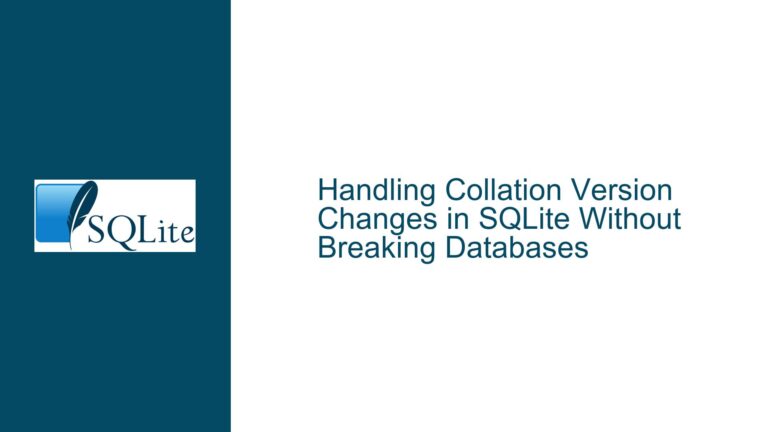Using Rootpage as a Stable Table Identifier in SQLite: Risks and Alternatives
Understanding Rootpage Stability and Risks in SQLite
The rootpage column in SQLite’s sqlite_schema table (formerly sqlite_master) stores the integer page number of the root page for a table or index within the database file. This value represents the starting point of the B-tree structure that organizes the table’s data. Developers exploring schema metadata often consider using rootpage as a stable identifier for tables due to its uniqueness and apparent persistence. However, relying on rootpage for long-term table identification introduces risks rooted in SQLite’s internal storage mechanics.
Role of Rootpage in SQLite’s File Format
SQLite databases are structured as a collection of fixed-size pages (default 4KB). The first page (page 1) contains the schema table (sqlite_schema), which itself is a B-tree. Each entry in sqlite_schema corresponds to a database object (table, index, view, or trigger). For tables and indexes, the rootpage column indicates the page number where the B-tree for that object begins. This design allows SQLite to efficiently traverse the database structure by following page pointers.
Key Questions About Rootpage Stability
The original forum discussion revolves around two critical questions:
Can two tables share the same
rootpagevalue?
Concurrently, no. At any given moment, each table or index has a uniquerootpagevalue. However, if a table is dropped and its storage pages are recycled, a new table might later occupy the same root page. This serial reuse is possible because SQLite’s free-list mechanism repurposes freed pages.Under what circumstances might a table’s
rootpagechange?
Therootpagevalue can change during operations that reorganize the database file, such asVACUUM, manualREINDEX, orALTER TABLE. These operations rebuild database objects, potentially assigning new root pages. Even routine operations like deleting large amounts of data followed by auto-vacuum can trigger page reallocation.
SQLite Internals and Documentation Insights
The SQLite Database File Format documentation clarifies that page numbers are transient. The VACUUM command rebuilds the entire database file, discarding unused pages and reassigning root pages in the process. As Richard Hipp (creator of SQLite) noted in the forum thread, VACUUM "scrambles" root page numbers. This behavior is not limited to non-system tables; even the sqlite_schema table’s root page (page 1) is fixed only in a newly created database. After VACUUM, the schema table could theoretically occupy a different page, though SQLite’s implementation ensures it remains on page 1 for compatibility.
Factors Leading to Rootpage Instability and Identifier Conflicts
1. Database Maintenance Operations
The VACUUM command is the primary culprit for rootpage instability. When executed, VACUUM rebuilds the database by copying all data to a temporary file, then replacing the original. This process eliminates fragmented pages and reduces file size but reassigns root pages in an unpredictable order. For example, a table initially created with rootpage 5 might end up with rootpage 12 after VACUUM.
Auto-vacuum mode introduces similar risks. When enabled, SQLite automatically truncates the database file after transactions, which can alter page layouts incrementally. While less disruptive than full VACUUM, auto-vacuum still allows root page changes over time.
2. Schema Modifications and Object Recreation
Operations like DROP TABLE followed by CREATE TABLE can recycle root pages. Suppose a table employees uses rootpage 100. If it’s dropped and recreated, the new employees table might receive a different rootpage, especially if other objects were created or modified in the interim. Even renaming a table (ALTER TABLE RENAME TO) does not guarantee rootpage stability if the operation triggers an implicit rebuild.
Indexes further complicate this: rebuilding an index (via REINDEX) changes its rootpage. While indexes are separate from tables, this illustrates SQLite’s broader tendency to reassign root pages during structural changes.
3. Rowid Stability in sqlite_schema
A forum participant suggested using the rowid of sqlite_schema as a stable identifier. However, rowid values in SQLite are stable only if the table is not subjected to VACUUM or other operations that alter row order. Since sqlite_schema itself is a table, its rowid values can change during maintenance. Richard Hipp confirmed this limitation, noting that rowid persistence is not guaranteed across VACUUM.
4. Transient Nature of Table Names
Relying on table names as identifiers has its own risks. Applications might rename tables dynamically, and name collisions could occur if tables are dropped and recreated with the same name but different schemas. While less volatile than rootpage, table names are not immune to change.
Implementing Reliable Table Identification Strategies in SQLite
1. Custom Lookup Table with Stable IDs
The safest approach is to create a dedicated table mapping application-defined integer IDs to table names. This table can include additional metadata (e.g., creation timestamp, schema version) and is managed explicitly by the application.
Schema Example:
CREATE TABLE table_registry (
table_id INTEGER PRIMARY KEY AUTOINCREMENT,
table_name TEXT NOT NULL UNIQUE,
created_at TIMESTAMP DEFAULT CURRENT_TIMESTAMP
);
Inserting Entries:
INSERT INTO table_registry (table_name) VALUES ('employees');
Advantages:
- Full control over ID assignment and stability.
- Immune to SQLite internals like
VACUUMor page reallocation. - Allows versioning and tracking historical schema changes.
Maintenance Considerations:
- Use triggers or application logic to update the registry when tables are created/renamed.
- For schema changes, employ transactions to ensure registry consistency.
2. Trigger-Based Automation
To automate synchronization between the registry and schema changes, create triggers on the sqlite_schema table. Note that SQLite restricts direct modifications to sqlite_schema, but triggers on schema changes can update the registry.
Example Trigger for Table Creation:
CREATE TRIGGER track_new_table AFTER CREATE ON DATABASE
WHEN TYPE = 'table'
BEGIN
INSERT INTO table_registry (table_name) VALUES (NEW.name);
END;
Caution:
SQLite’s CREATE TRIGGER for schema events requires careful testing, as errors in triggers can disrupt schema operations.
3. Leveraging SQLite’s Application ID
SQLite databases have a 32-bit "application ID" in the file header, which is unrelated to table identifiers but demonstrates that custom metadata can be embedded. While not directly useful for table tracking, this feature underscores SQLite’s flexibility in supporting user-defined metadata strategies.
4. Avoiding Unstable Operations
If rootpage must be used temporarily, disable operations that invalidate it:
- Avoid running
VACUUMmanually or via auto-vacuum. - Prefer
DELETEoverDROP TABLEfor data removal, asDELETEdoes not release root pages immediately.
Trade-offs:
- Increased database file size due to fragmentation.
- Reduced performance from unoptimized page layouts.
5. Cross-Database Comparison
Understanding SQLite’s limitations relative to other systems informs better design choices:
- PostgreSQL: Uses stable OIDs (object identifiers) for system tables, but user tables lack OIDs by default.
- MySQL:
INFORMATION_SCHEMAtables provide metadata, but their contents are generated dynamically and not storable.
SQLite’s simplicity necessitates custom solutions, whereas other databases offer built-in stable identifiers at the cost of complexity.
Final Recommendations
- For short-lived databases:
rootpagemight suffice ifVACUUMis avoided, but this is risky. - For production systems: Implement a
table_registrywith application-managed IDs. - For auditing/history: Extend the registry to track schema versions and alterations.
By prioritizing control over convenience, developers can ensure stable table identification regardless of SQLite’s internal page management behavior.






